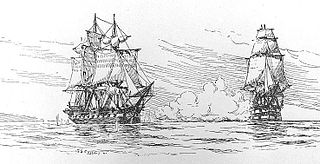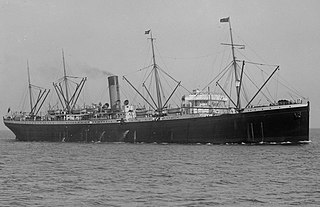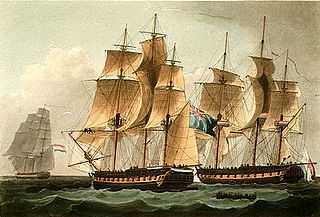
The Mauritius Command is the fourth naval historical novel in the Aubrey-Maturin series by Patrick O'Brian, first published in 1977.
HMS Sceptre was a 64-gun third-rate ship of the line of the Royal Navy, launched on 8 June 1781 at Rotherhithe. The ship was wrecked in a hurricane on 5 November 1799 in Table Bay near the Cape of Good Hope.

HMS Birkenhead, also referred to as HM Troopship Birkenhead or Steam Frigate Birkenhead, was one of the first iron-hulled ships built for the Royal Navy. She was designed as a steam frigate, but was converted to a troopship before being commissioned.

HMS Leopard was a 50-gun Portland-class fourth rate of the Royal Navy. She served during the French Revolutionary and Napoleonic Wars, and was notable for the actions of her captain in 1807, which were emblematic of the tensions that later erupted in the War of 1812 between Britain and America. She was wrecked in 1814.
HMS Leda, launched in 1800, was the lead ship of a successful class of forty-seven British Royal Navy 38-gun sailing frigates. Leda's design was based on the French Hébé, which the British had captured in 1782. Leda was wrecked at the mouth of Milford Haven in 1808, Captain Honeyman was exonerated of all blame, as it was a pilot error.

HMS Diamond was a D-class destroyer built for the Royal Navy in the early 1930s. The ship spent the bulk of her career on the China Station. She was briefly assigned to the Mediterranean Fleet in 1939 before she was transferred to West Africa for convoy escort duties. Diamond returned to the Mediterranean Fleet in early 1940 where she generally escorted convoys to and from Malta. The ship participated in the Battle of Cape Spartivento in November. Diamond was sunk by German aircraft on 27 April 1941 whilst evacuating Allied troops from Greece.
Tryall was a British East India Company-owned East Indiaman launched in 1621. She was under the command of John Brooke when she was wrecked on the Tryal Rocks off the north-west coast of Western Australia in 1622. Her crew were the first Englishmen to sight or land on Australia. The wreck is Australia's oldest known shipwreck.

HMS Anson was a ship of the Royal Navy, launched at Plymouth on 4 September 1781. Originally a 64-gun third rate ship of the line, she fought at the Battle of the Saintes.

SS Suevic was a steamship built by Harland and Wolff in Belfast for the White Star Line. Suevic was the fifth and last of the Jubilee-class ocean liners, built specifically to service the Liverpool-Cape Town-Sydney route, along with her sister ship Runic. In 1907 she was wrecked off the south coast of England, but in the largest rescue of its kind, all passengers and crew were saved. The ship herself was deliberately broken in two, and a new bow was attached to the salvaged stern portion. Later serving as a Norwegian whaling factory ship carrying the name Skytteren, she was scuttled off the Swedish coast in 1942 to prevent her capture by ships of Nazi Germany.
Captain Sir Charles Marsh Schomberg was an officer of the British Royal Navy, who served during French Revolutionary and Napoleonic Wars, and later served as Lieutenant-Governor of Dominica.

RMS Alaunia was an ocean liner owned by the Cunard Line. She was built in 1913 at Greenock and measured 13,405 tons gross. She was one of the three ships Cunard ordered Scotts Shipbuilding and Engineering Company to build. These three ships were RMS Andania, Alaunia, and RMS Aurania. The Alaunia was the second of these three ships. She and her sisters had only 2nd class and 3rd class. She had two funnels and is not the ship in the attached photo

Arniston was an East Indiaman that made eight voyages for the British East India Company (EIC). She was wrecked on 30 May 1815 during a storm at Waenhuiskrans, near Cape Agulhas, South Africa, with the loss of 372 lives – only six on board survived. She had been chartered as a troopship and was underway from Ceylon to England on a journey to repatriate wounded soldiers from the Kandyan Wars.

Pierre-François-Henri-Étienne Bouvet de Maisonneuve was a French Navy officer and privateer.

RMS Andania was a passenger-cargo ship built by Scotts Shipbuilding and Engineering Company of Greenock. She was launched on 22 March 1913 and was completed on 13 July 1913.

HMS Wilhelmina was a 32-gun fifth-rate frigate of the Royal Navy. She was previously a Dutch ship and had been built in 1787 for the Dutch Republic as the Wilhelmina. She was renamed Furie in 1795, after the establishment of the Batavian Republic as a client state of the First French Empire. Like other Dutch ships at that time, she was pressed into service as part of French plans to support the Irish Rebellion of 1798 in the hope of destabilising Britain. The British captured her and the Dutch corvette Waakzaamheid in 1798 while the two were supporting French and Irish forces involved in the Irish Rebellion. The Royal Navy took both into service, with Furie regaining her original name. Sailing as HMS Wilhelmina, she spent the bulk of her later career in the East Indies, serving mostly as a troopship. Here she fought an unequal battle against a large French privateer, and succeeded in driving her off and protecting a merchant she was escorting. Wilhelmina was almost the ship that faced a superior French squadron at the Battle of Vizagapatam, but she was replaced beforehand by the larger HMS Centurion. She spent the rest of her days as a guardship in Penang, and was sold there in 1813.

SS Slamat was a Dutch ocean liner of the Rotterdam-based Koninklijke Rotterdamsche Lloyd line. Although she was a turbine steamship, she tended not to be referred to as "TSS". She was built in Vlissingen in the Netherlands in 1924 for liner service between Rotterdam and the Dutch East Indies. In 1940 she was converted into a troop ship. In 1941 she was sunk with great loss of life in the Battle of Greece.
The Slamat disaster is a succession of three related shipwrecks during the Battle of Greece on 27 April 1941. The Dutch troopship Slamat and the Royal Navy destroyers HMS Diamond and HMS Wryneck sank as a result of air attacks by Luftwaffe Junkers Ju 87 dive bombers. The three ships sank off the east coast of the Peloponnese during Operation Demon, which was the evacuation of British, Australian and New Zealand troops from Greece after their defeat by invading German and Italian forces.

HMS Harpy was a Royal Navy Diligence-class brig-sloop, launched in 1796 and sold in 1817. She was the longest lived vessel of her class, and the most widely travelled. She served in both the battle of Copenhagen and the British invasion of Java, took part in several actions, one of which won for her crew a clasp to the Naval General Service Medal, and captured numerous privateers. The Navy sold her in 1817.

Warren Hastings was a three-decker East Indiaman, launched in 1802. The French captured her in 1805 during her second voyage for the East India Company and sold her to Danish owners. The British recaptured her in January 1808, and within a year thereafter she was again in her former owner's hands. She then made several more voyages for the company.
Asia was launched at Liverpool in 1798. She competed four voyages for the British East India Company (EIC), and wrecked on her fifth. During the second she transported EIC troops to Macao to augment the Portuguese forces there, but the authorities there refused them permission to land. She was wrecked in 1809 on the outbound leg of a voyage to Madras and Bengal.
















